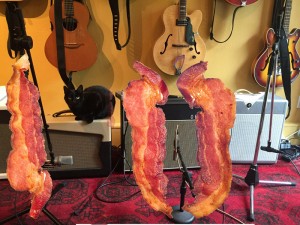
Premier Guitar just posted my column on simultaneously recording multiple amps to create cool composite tones, both by blending their default sounds in varying way, or using only selected frequency “slices” from each amp and assembling them in layers (hence the amp sandwich metaphor).
According to one PG reader, “It ain’t a sandwich without bacon.” So I Photoshopped in a few slices. :pacman:
What happens when you mix Fender-style Carr highs, Marshall lows, and tweed-like Divided by 13 mids? It sounds something like this.








sounds great! Although I lack a wall of vintage/boutique amps… 🙂 However, the new effect chain/split/parallel features in Studio One 3 should make for some fun itb experiments along these lines. https://www.youtube.com/watch?v=YA-ODMD19as
Yeah, that should work great. I’ve done lots in a similar vein with the guitar tools in Logic. Hmm … maybe another blog topic?
That is interesting and to be fair , just picking an amp and a guitar and plugging straight in will never give you more options.You can certainly get one fantastic sound that way but almost nothing musical has only one sound in it. Everything is better with bacon!!!!!!!! Nice work Joe and it does depend on the context !
I have been a big proponent of multiple amps when recording or playing since the late 70’s. I particularly like amps with disparate spkr sizes, like my Ampeg Gemini II 15″ spkr and an Egnater Tweaker with a closed back 2-10 cab from an old Gibson 120 stereo amp. This gives a combo of very different tones but I don’t tend to move them to far apart in the mix because of the verb and vibrato on the Gemin II. I also sometimes add in a Sunn bass combo with a 15″ closed back for a clean low end I EQ it during mixing and it sparingly. I also like to take a fairly clean signal straight thru the board to mix in but I don’t really like re-amping so it is just a little clean for clarity. I have 15 guitar amps in my studio for this purpose (I got a lot of really sweet deals on broken amps in my repair business over 30 years of amp repairs). The one thing that i would like to stress is that this can give you some serious ground loops with a lot of hum this tempts guitarists to defeat the third ground pins on their amps either by removal or those little gray bastards with the green wire. DON’T defeat the AC ground it is there to keep you from getting zapped to death, while I would prefer dying with a guitar in my hands I have a lot of music to let out yet so I’m not ready to go for a lack of grounding.. I use Ebtech HumX AC power units to eliminate the ground loops. These maintain the safety while killing the ground loops. I highly recommend them.
I just saw the illustration they ran in Premier Guitar for the article “The Guitarist’s Toolkit: Sharpening the Rhythm Blade” featuring a photoshopped pink Hello Kitty guitar. Is this writer Miles Okazaki stealing your bit? https://www.premierguitar.com/articles/22665-the-guitarists-toolkit-sharpening-the-rhythmic-blade
I was wondering how those Ebtech Hum X units worked. They use the word ‘filter’ but that doesn’t seem to be what they do. Basically they appear to insert two 6A diodes wired back to back into the ground return. The idea is that small (audio level) signals circulating in the ground connection aren’t enough to exceed the diodes 0.7v forward conduction point, so for low level signals the equipment on the other side of the Hum X acts as though it were not grounded through its power cable. If any serious level of voltage (possibly lethal) appears the diodes conduct to ground.
I think the Ebtech units also have a resistor and a capacitor to help with any RF, but if you bought a bag of 6A 200V or even 400V diodes you could roll your own hum killers. After all they seem to charge 75 bucks for these things.
The HumX’s work great they eliminate ground loops completely. They are UL listed and well built, the average guitarist is not going to build it themselves nor should they. I can understand the price as they need to carry liability insurance which is more expensive for this type product. Even still you only need one for two amps and you are buying safety. They sound a lot better than isolation xfrms for the amp input signals (IMHO the xfrmrs limit some of the preamp/pickup interaction).. Beyond that $75 is not a huge outlay compared to a pedal or replacement pickups but I contend they are a good safety investment and ground loop hum sounds like ass. I got mine for around $50 on sale. I have replaced so many three pin plugs with the ground pin removed repairing amps that I loss count 20 years ago. I have also removed and confiscated way too many “ground adapters” I know of at least two guitarists that spent time in a hospital after getting zapped by guitar amps that had AC wiring problems that caused the chassis to have one side of the AC line shorted to it.if the ground pins had not been cut off the AC plugs the breakers would blow at the power panel at worst case or blow an AC fuse on the amp if wired properly. In my opinion amps should have this sort of grounding scheme built in during manufacture we aren’t talking much in parts cost.